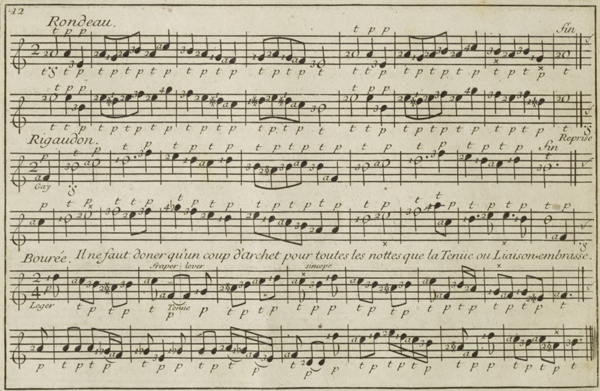A Timeline history of the Violin Bow - from c. 1600 - 1800
... the sources in detail ...
Michel Pignolet de Montéclair (1667 - 1737)
Méthode facile pour apprendre à jouer du violon (Paris, 1711-12)
Montéclair's Méthode facile pour apprendre à jouer du violon is the fist violin treatise in France. It is fairly short (only 24 pages) and elementary, but nonetheless informative. About holding the bow he writes;

"The bow is held with the right hand, the four fingers placed on the wood, and the thumb under the frog which holds the hair. It is necessary to accustom oneself to pull the bow evenly from one end to the other, and the up bow as well without letting the string scream. In fast passages one should not grip the bow between the fingers, nor stiffen the wrist nor the elbow, because it is through the ease of their movement that one acquires a beautiful bow-stroke."
Five pages later, he proceeds with some examples showing the order of up and down bows (t = tirer = down bow, p = pousser = up bow). In duple time, he illustrates exactly what we have come to expect - a simple adjustment (either two ups, or re-taking a down) to achieve a down bow on the next bar-line:

In simple triple time, also, he illustrates the two ways to achieve the bar-line down bow - two ups (craquer, after Muffat), or a new down on the bar-line:

In the Sarabande, two points of note: First, in contrast to Bismantova's down-bow on the dotted half-note on the second beat, he suggests an up-bow. Second, he gives as an alternative a rather surprising bowing - namely in bars 3 and 4 he seems to allow 'backwards' bowing (similar in 6 & 7, but here it is 'corrected' much sooner, and could be seen as an acknowledgement of the hemiola):

As we get to faster triple time, the requirement for a new down on every bar-line is weakened:

In the Loure, both bowing through the bar, and retaking on the middle are possible:

And in the gigue, 'as it comes' is recommended, but it doesn't seem to matter with or against the barline. Note bar 4 and at the double bar, where his upper bowing shows the longer note at the end of each phrase on an up bow, and then retaking an up-bow for the up-beat - this suggests a bowing style rather towards the point than at the frog. Towards the end of the example, his bowings start to become inconsistent, I'm not quite sure what he means anymore!

He ends with 5 pages of duets for two violins, with very thorough bowing marks. These are well worth looking at, as they show a number of bowings that seem curious - awkward ups on main notes, inconsistencies on repeated phrases, different bowings in the two parts, where alignment would be simple ... Particularly interesting is his very last example, which comes from the last movement of his Cantata, Le Retour de la Paix, where the first violin and second violin (imitating a trumpet) have fundamentally different bowing - violin 1 has a well organised down bow on every down-beat, whereas violin 2 bows simply as it comes. Is this to illustrate the relatively equal accentuation of a fanfaring trumpet?







